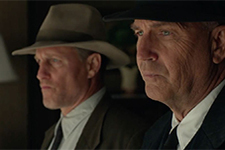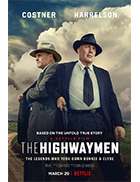The Highwaymen
|  If the old truism is right that villains make the most interesting characters, then John Lee Hancock’s The Highwaymen faces a particularly steep challenge in telling the story of the notorious Depression-era criminals Bonnie and Clyde through the lens of the lawmen who spent five months pursuing them across nine states. This is particularly tricky material as a movie because the characters of Bonnie and Clyde have not only been already depicted, but cinematically enshrined in the charismatic teaming of Warren Beatty and Faye Dunaway at their glamorous best in Bonnie and Clyde (1967), Arthur Penn’s seminal game-changer that rewrote the rules of American cinema with its quick wit, rapid tonal shifts, graphic violence, European art film aesthetic, and outlaw spirit. The Highwaymen has the stodgy, potentially thankless duty of essentially making good on New York Times critic Bosley Crowther’s curmudgeonly take-down of Penn’s classic, in which he complained that the film, which he called “a cheap piece of bald-faced slapstick comedy,” treated “the hideous depredations of that sleazy, moronic pair as though they were as full of fun and frolic.” That was beginning of the end of Crowther’s storied career as the standard bearer of mainstream American film criticism because it was indisputable evidence that he was officially behind the times, but his words are not completely (just mostly) without merit, at least from a historical standpoint. Penn’s film is more fantastical legend than fact, using the notorious outlaws as symbols of stick-it-to-the-man late ’60s counterculture rebellion wrapped up in ’20s high style. The Highwaymen seeks to remind us that Bonnie Parker and Clyde Barrow were, in fact, cold-blooded killers who left a trail of often senseless death in their wake, even as it also emphasizes their mythical status by keeping them deliberately framed from behind and at low angles that obscure their faces, which turns them into a different kind of glamorous icon (one wonders if the film wouldn’t have been better if we hadn’t seen them at all). The film, which was written by veteran screenwriter John Fusco (creator of the 2014–2016 Netflix series Marco Polo), begins with the “Eastham Breakout” of 1934, in which Bonnie and Clyde helped plan and execute the jail break of several inmates at a prison farm in southeast Texas as a means of getting revenge on the Texas Department of Corrections (at this point, they had been wanted for murder for nearly two years). This event is the final tipping point for Texas Governor Ma Ferguson (Kathy Bates), who bows to pressure from Lee Simmons (John Carroll Lynch), head of the Texas prison system, to get the Texas Rangers involved in hunting down Bonnie and Clyde. Simmons approaches Frank Hamer (Kevin Costner), a Ranger captain who retired two years earlier and is living with his socialite wife Gladys (Kim Dickens) in a highly domesticated existence that stands in stark contrast to his legendary status as a hardened lawman with a long list of dead criminals. Hamer equivocates, but eventually accepts the job and then recruits Maney Gault (Woody Harrelson), another retired Ranger who is struggling with his post-lawman life, primarily by drinking. Hamer and Gault—who are officially hired as members of the Texas Highway Patrol, hence the film’s title—make for a duo almost as intriguing as Bonnie and Clyde, which is what makes the film work as more than just gimmicky cinematic revisionism. Costner and Harrelson develop a strong chemistry in which much is often said, but quite a bit is left unsaid, as well. Costner is as gruff and flinty as we would expect his character to be, but he consistently reveals flecks of humanity behind the armor—especially regret about the violence that has defined his life, even as he continues to engage in it out of his own sense of righteousness. Harrelson has the more complex character, as Gault is truly struggling and more often than not losing, and his being recruited to join Hamer in hunting down Bonnie and Clyde creates an ironic lifeline for him—or at least a temporary reprieve from his slow slide into despondency—as he is the duo’s conscience, wearing on his sleeve all the guilt for their lifetime of bloodshed that Hamer keeps mostly repressed. Gault also gets the film’s best scene, in which he regales a group of young lawmen itching for great stories about the “old days” with a tale of how he and Hamer were part of a group of Rangers that tracked down and slaughtered a large group of outlaws along the Texas-Mexico border. It’s the stuff of legend, but Harrelson tells it as a weary fable of the endless cycle of violence, and the overall effect of it is akin to Robert Shaw’s infamous U.S.S. Indianapolis monologue in Jaws (1975) in the way it undercuts our expectations and forces us to rethink a character we thought we knew. It gives the film a real sense of conscience, which Bosley Crowther probably would have admired. Copyright © 2019 James Kendrick Thoughts? E-mail James Kendrick All images copyright © Netflix |
Overall Rating: 

 (3)
(3)


